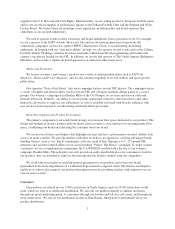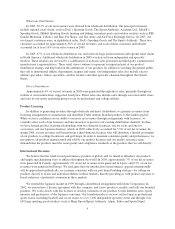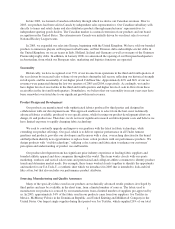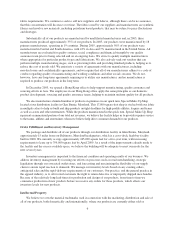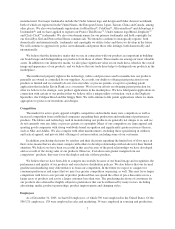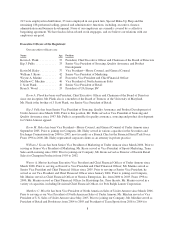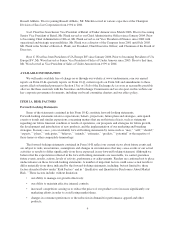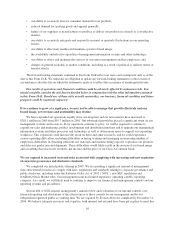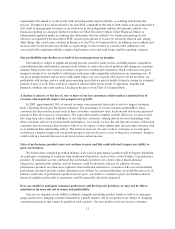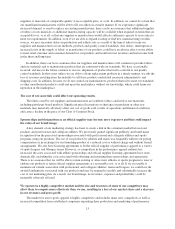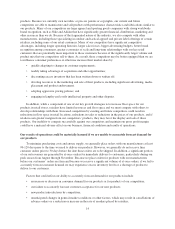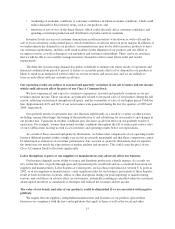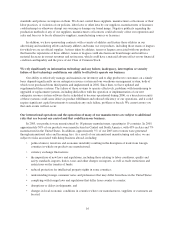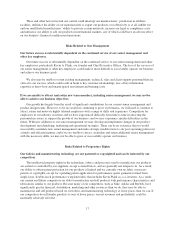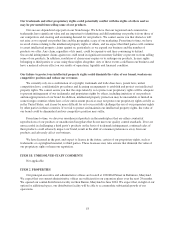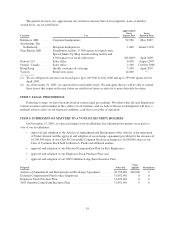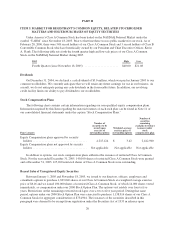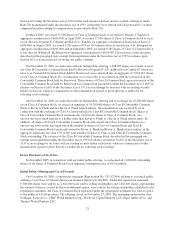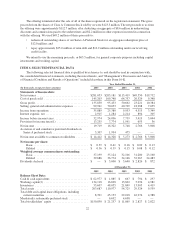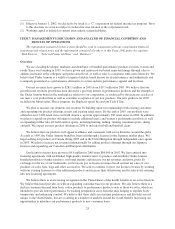Under Armour 2005 Annual Report Download - page 19
Download and view the complete annual report
Please find page 19 of the 2005 Under Armour annual report below. You can navigate through the pages in the report by either clicking on the pages listed below, or by using the keyword search tool below to find specific information within the annual report.suppliers of materials of comparable quality at an acceptable price, or at all. In addition, we cannot be certain that
our unaffiliated manufacturers will be able to fill our orders in a timely manner. If we experience significant
increased demand, or need to replace an existing manufacturer, there can be no assurance that additional supplies
of fabrics or raw materials or additional manufacturing capacity will be available when required on terms that are
acceptable to us, or at all, or that any supplier or manufacturer would allocate sufficient capacity to us in order to
meet our requirements. In addition, even if we are able to expand existing or find new manufacturing or fabric
sources, we may encounter delays in production and added costs as a result of the time it takes to train our
suppliers and manufacturers in our methods, products and quality control standards. Any delays, interruption or
increased costs in the supply of fabric or manufacture of our products could have an adverse effect on our ability
to meet retail customer and consumer demand for our products and result in lower revenues and net income both
in the short and long term.
In addition, there can be no assurance that our suppliers and manufacturers will continue to provide fabrics
and raw materials and to manufacture products that are consistent with our standards. We have occasionally
received, and may in the future continue to receive, shipments of product that fail to conform to our quality
control standards. In that event, unless we are able to obtain replacement products in a timely manner, we risk the
loss of revenues resulting from the inability to sell those products and related increased administrative and
shipping costs. In addition, because we do not control our manufacturers, products that fail to meet our standards
or other unauthorized products could end up in the marketplace without our knowledge, which could harm our
reputation in the marketplace.
The cost of raw materials could affect our operating results.
The fabrics used by our suppliers and manufacturers are synthetic fabrics and involve raw materials,
including petroleum-based products. Significant price fluctuations or shortages in petroleum or other raw
materials may materially adversely affect our cost of goods sold, results of operations and financial condition,
and cause a decline in the price of our Class A Common Stock.
Sponsorships and designations as an official supplier may become more expensive and this could impact
the value of our brand image.
A key element of our marketing strategy has been to create a link in the consumer market between our
products and professional and collegiate athletes. We previously gained significant publicity and brand name
recognition from the perceived sponsorships associated with professional and collegiate athletes and sports
programs using our products. The use of our products by athletes and teams was frequently without our paying
compensation or in exchange for our furnishing product at a reduced cost or without charge and without formal
arrangements. We also have licensing agreements to be the official supplier of performance apparel to a variety
of sports leagues and Olympic teams. However, as competition in the performance apparel industry has
increased, the costs associated with athlete sponsorships and official supplier licensing agreements have risen
dramatically, including the costs associated with obtaining and retaining these sponsorships and agreements.
There is no assurance that we will be able to retain existing or attract new athletes or sports programs to wear or
endorse our products or retain official supplier agreements at a reasonable cost, or at all. If we are unable to
maintain our current association with professional and collegiate athletes, teams and leagues, we could lose the
on-field authenticity associated with our products and may be required to modify and substantially increase the
cost of our marketing plan. As a result, our brand image, net revenues, expenses and profitability could be
materially adversely affected.
We operate in a highly competitive market and the size and resources of some of our competitors may
allow them to compete more effectively than we can, resulting in a loss of our market share and a decrease
in our revenues and gross profit.
The market for active sports apparel is highly competitive and includes many new competitors as well as
increased competition from established companies expanding their production and marketing of performance
13


